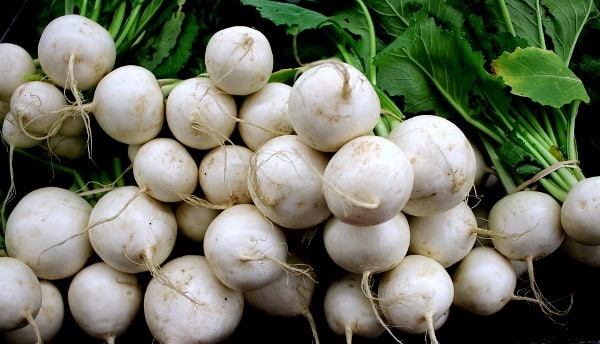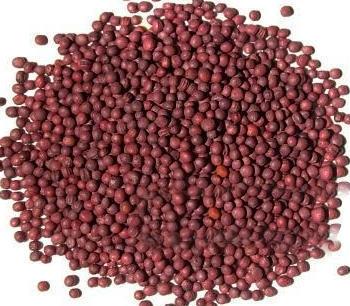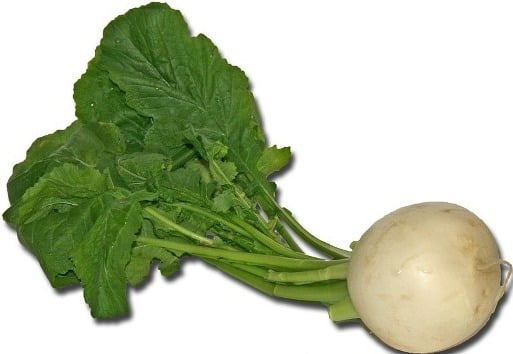Growing Turnips in Containers:
Introduction To Growing Turnips in Containers: The turnips are the root vegetables, grown in temperate regions round the world for its white, bulbous taproot and green leaves. Small and tender Turnips are grown for human consumption, while larger turnip varieties are grown for feeding livestock. Most common turnip we see have white-skinned, and the part (about 1-6 centimeters) which is projected above the ground will be in purple or red or greenish due exposure to the sun has hit. The part of turnip projected above the ground develops from stem tissue, and it is fused with root. The turnips have complete white flesh. The turnips will be about 5-20 centimeters in diameter and don’t have any side roots. The leaves grow from the part root above the ground shoulder.
Turnips are cool-season crops grown for their tender roots or tender leaves. Planting turnips in containers have many advantages, Vegetables in containers can be easy to care for, we just need suitable container and good quality potting soil. Sow turnip seeds in early spring for use in early summer or in late summer or autumn for winter use.
Leaves of turnips are also edible, and they taste like mustard greens. The people USA consumes turnips leaves as a common side dish mainly during late fall and winter. Small and young leaves have a great taste, and large and well grown leaves may have a bitter taste. There are many varieties of turnips mainly leaves and some have no storage roots. Like cabbage and radish, turnip leaves and roots have a pungent flavor that turns off when cooked.

Turnip is a biennial plant, which takes two years to grow. Plants takes a year for root production and in the second year it produces flowers, seeds and completes its life. The flowers of the turnip are tall and yellow and produces seeds like pea-pods.
Turnip weighs up to 2.2lbs, but usually these veggies are picked when they are small. There are special variety of turnips that grow very small, and these turnips should be eaten fresh and not suitable for storage. Small varieties of turnips come in yellow-, orange-, and red-fleshed varieties, as well as white-fleshed. These roots have a very mild flavor is mild and they can be eaten raw.
Leaves of turnips are a great source of water, carbohydrates, Vitamins A, K, C, Folate and proteins. And cooked turnips are rich in vitamin C, Micronutrients, carbohydrates, proteins with negligible fat.
- Scientific Name for Turnips: Brassica rapa.
- Turnips Belongs to the family of: Brassicaceae.
- Common names for Turnips: Turnip, Swede, and Shalgam.
Varieties of Turnips for Growing Turnips in Containers:
Turnips belongs to family of broccoli, cabbage, mustard, and kale. There are different types of turnips with round shape and long carrot-like shape, with skin in pure white purple or red. Flesh of the turnips comes e white, yellow, golden, or red-veined depending on the variety, and they taste bitter to smooth and creamy like apples.
Baby Turnips: These “Baby turnips” have a very less harvesting period, and these turnips are special varieties which never grow large, and come in white, orange, yellow, or red flesh, with a mild flavor. These turnips are usually eaten raw, grown for salads.
Some Varieties of Turnips are:
Early Harvest Turnips:
These turnips have a very short harvesting period. There are varieties for you that mature early.
- Market Express – These turnips have a very short harvesting period of 38 days. These turnips have pure white roots. These are baby turnips that have mild flavor.
- Hakurei – fast producing baby turnips, have white root that has a sweet flavor. These mostly used in restaurants. Maturing period is 38 days.
- Tokyo Cross – very popular all-white hybrid, these are fast growing turnips; the maturing period is 35 days. Greens can be harvested in 35 days.
Colorful Turnips:
These turnips have colorful flesh or skin.
- Scarlet Queen: These turnips have typical white flesh, with a scarlet skin color gives a great look to the salads. These turnips are highly disease resistant.
- Gilfeather – These turnips are egg-shaped heirloom and have a creamy white flesh and with smooth leaves. These turnips have a mild taste.
- Golden Ball turnips: These turnips have sweet, yellow flesh and skin.
All White Turnips:
These turnips are completely having white skin and flesh.
- White Knight – these turnips come in pure white globe shape and have a spicy turnip flavor.
- White lady turnips have a very sweet taste.
- Tokyo Cross.
- White Knight: These turnips have flattened oblong shape, have white skin and flesh.
Turnips for Greens:
These turnips varieties are grown for their greens.
- Alltop – these turnips are famous for their tops, these turnips are hybrid variety.
- Seven Top – these are heirloom variety turnips, these are grown only for its large, dark green edible leaves.
- Topper –These turnips are fast growing, produces heavy yields of greens.
- Shogoin – these turnips are a great choice for growing tender, mild tasted white root. These turnips produce tasty greens.
Standard Turnips:
These standard turnips have purple color at the top and white at the bottom, with white colored flesh. These standard turnip varieties have a familiar spicy turnip taste. There are many varieties of turnips available:
- Purple-topped turnip varieties of turnips are Royal Globe and Royal Crown.
- Purple Top White Globe.
Propagating Method for Growing Turnips in Containers:
Right way to propagate turnips are through sowing seeds. If you are planning to collect seeds from your turnips for propagation, the result might be disappointing. To collect seeds from home grown turnips, you need to prevent cross-pollination. It is recommended to purchase high-quality seed from nearby gardening centers or nurseries and provide proper growing conditions, your favorite turnips are easily grown with minimal care. You need to purchase certified and disease resistant turnip seeds.
Climate for Growing Turnips in Containers:
Turnips grow well in a good amount of sunlight, Best time for planting turnips is the spring or late summer.
- Early Turnips: Best time to plant early turnips, sow the seeds in February under cloches.
- Other turnips can be planted from March to June.
The Ideal time for growing turnips for leaves is from August to September.
- For baby turnip varieties, sow the seeds from July to mid- August.
Suitable Container for Growing Turnips in Containers:
Turnips are the root vegetables, so the container you select should give enough space for growing. And the container should have a good draining system and should maintain suitable temperature levels, so make sure that container should have 2 draining holes. Select the container with more depth than the depth of your plant space. A 12-inch container is the ideal size of the container that gives enough space for the turnip plants to grow.
Turnips plants are not suitable for transplanting, so choose the container that gives sufficient space for its complete lifecycle. Use the container made of plastic or terracotta or clay for growing turnips. Recycled container like wine barrels, wooden crates or paint buckets are also suitable for growing turnips. Geo bags are also a good choice for growing turnips. Turnips need cool soil, to maintain soil temperature use light colored container which reflects light.
Place a thin layer covering the draining holes with small stones/gravel or fine mesh or two to three layers of newspaper at the bottom of the container to avoid dripping of the soil. Placing thin layers of gravel on the bottom of your container will prevent the soil from getting too soggy.
Soil Preparation for Growing Turnips in Containers:
- For growing turnips in a container, choose well-drained loamy soil rich in organic matter.
- If you are gardening soil, make sure soil is disease free. Mix the soil with plenty of river sand to increase its draining capability.
- The pH level of the soil should be around 6.5.
- Instead of using garden soil, go for compost enriched high quality potting soil.
- Before filling the container with potting soil, mix the slow release fertilizer into potting before planting. Use granular fertilizer of ration 10-10-10 or 14-14-14.
Ideal Temperature for Growing Turnips in Containers:
- Ideal temperature for growing turnips is from 7 to 23 degrees.
- Turnips are cool crops, so they should be taken proper care during the peak summer. They should be grown under garden cloches when the temperature goes too up or too low.
- The soil temperature should be between 10 to 20 degrees for growing healthy and tasty turnips.
Propagating Turnips from Seeds:

- Get the best quality turnips seeds from a well-known dealer, soak the seeds in warm water in a bowl to fasten the germination.
- Fill the container with the potting soil, leaving 1-inch gap between the surface of the soil and the rim of the container.
- Now, Plant turnip seeds 2 to 3 inches apart if growing turnip plants for their roots. Sow seeds ½-inch deep. If you are planning to grow turnip plants for their greens, just sprinkle approximately 10 to 15 seeds in a container with a 12-inch diameter.
- Cover the seeds with 1/2-inch layer of potting soil.
- Place the turnips seed container in a sunny location.
- Seeds takes 5 to 6 weeks to germinate. Once the plant reaches 3 inches high. Cut off the smaller seedlings, allowing just one to grow to maturity.
- Check the container regularly, for maintaining the constant moisture levels. As the plants grown in containers dry out quickly and watering should be done frequently. Check the top layer of the soil by poking the finger to the deep ½ inch in the soil, if you feel dry.
- Watering should be done deeply, until water begins to trickle from the draining holes.
- Prune the plants when the seedlings are 4 inches tall, giving 2 to 4 inches of space between each plant. Pruned tender leaves can be used in salad.
- Feed the turnip plants after 3 to 4 weeks of planting, using a balanced, water-soluble all-purpose vegetable fertilizer with a ratio such as 20-20-20 or 14-14-14.
Watering Requirement for Growing Turnips in Containers:
- Turnips plants should be watered at regular intervals, keep the soil moist constantly and well-drained.
- Watering deeply till the water drips out from draining hole, will avoid water clogging and makes soil moisture uniformly.
- In hot and dry weather increases the watering intervals. In winter reduce the water the plants twice in a week.
- Over watering can cause fungal diseases. Over the plants only at the base, don’t wet foliage.
Sunlight Requirement for Growing Turnips in Containers:
- Turnips grow well in full sun or partial shade.
- Turnips requires 6-8 hours of direct sunlight are required for an optimum growth of the root stock.
- Even through turnip grow well in full sunlight, it can also tolerate partial shade.
- If growing turnips for their greens, you can grow them in partial shade
Pruning and Mulching In Growing Turnips in Containers:
- When growing turnips for their roots, thin the growing turnips to about 4 inches apart to give the plants enough to form good roots.
- For Growing turnips for their leaves, prune them constantly will increase their growth.
- Apply a mulch when the plants are about 12cm height, as this will retain the moisture level of the soil.
- Mulching protects plants from weed, Regular inspection is also required to keep the plants weed free.
Fertilizers for Growing Turnips in Containers:
- Turnips are heavy feeders, when grown in container we should give a constant supply of nutrients for a healthy growth.
- Feed the plants, with a mild fertilizer every couple of weeks.
- Use organic fertilizers or natural compost for every 15 days.
- If you are growing turnips for their greens, feed the plants with nitrogen-rich fertilizer.
- If growing turnips for their roots, use organic potassium-rich fertilizer.
- Watering and feeding the plants generously will keep the turnip root from getting tough and woody. Never allow the soil to dry.
Pests and Diseases in Growing Turnips in Containers:
- Turnips are affected by common pests like beetles, aphids, and spider mates.
- Turnips can be affects White larvae, they lay eggs on the roots just below the soil surface, spoiling the growth and makes the plants to wilt and die. To protect plants from white larvae, grow the plants under pest proof mesh or horticultural fleece. Turnips seedlings are more vulnerable to white larvae.
- Turnip plants are most affected by Flea beetle. These pests cover under leaves and make small holes and affected leaves turn brown. Turnips seedling are much affected with these flea beetles. Water soluble nitrogen rich fertilizer will relieve plants from flea beetles.
- Turnips can be affected by powdery mildew. A white powder deposit over the leaf surface, make leaves dry and shrivel. Maintaining the constant moisture in the soil will keep plants away from powdery mildew.
- Club root is the major problem faced by turnips. The roots will become swollen and distorted, and leaves become pale and yellow and wilt easily. Club root makes plants die. To protect plants from clubroot disease, improve draining capability of the soil and add lime to make soil more alkaline.
Harvesting in Growing Turnips in Containers:

- Early harvesting of the greens and root is good for a better taste, and quality. Once the plant starts bolting, then it is too late to pick the root vegetables.
- Turnips should be harvested carefully, by using appropriate gardening tools.
- Turnip greens can be harvested in March and April.
- Turnip greens can be harvested when they reach 4 to 6 inches high. Constant harvesting will make green to grow back.
- Turnip roots can be harvested when they reach about 3 inches in diameter. Turnip roots can be harvested too early, but they should be harvested later. Late harvesting makes root, bitter and hard. Tender and young turnip roots have a great taste.
- Early turnips can be harvested from May to September when their root size is in the size of a golf ball. If planning to eat raw turnips, harvest them when their root size is in the size of a tennis ball.
- For baby turnips, pick the turnips from mid-October onwards, when the size of turnip root is in the size of a golf ball.
Storing Tips for Growing Turnips in Containers:
- Turnip roots can be stored in a refrigerator in an airtight bag for several months, at temperatures between 10 to 15 degrees.
- You can also store when in a root cellar covered in sawdust. Or can also store them under the ground till you use them.
- Or can store them by warping them with a heavy, layered mulch of straw, leaves, and branches.
- Greens of turnips can stay fresh for more than one week when stored in the refrigerator when sealed in an airtight container.